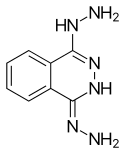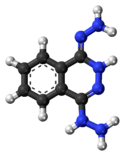 | |
 | |
| Clinical data | |
|---|---|
| AHFS/Drugs.com | International Drug Names |
| ATC code | |
| Identifiers | |
IUPAC name
| |
| CAS Number | |
| PubChem CID | |
| ChemSpider | |
| UNII | |
| KEGG | |
| ChEMBL | |
| CompTox Dashboard (EPA) | |
| ECHA InfoCard | 100.006.914 |
| Chemical and physical data | |
| Formula | C8H10N6 |
| Molar mass | 190.210 g·mol−1 |
| 3D model (JSmol) | |
SMILES
| |
| |
| (verify) | |
Dihydralazine is a drug with antihypertensive properties.[1] It belongs to the hydrazinophthalazine chemical class.[2] It has very similar effects to hydralazine.[2]
See also
References
- ^ Stern HC, Matthews JH, Belz GG (October 1984). "Influence of dihydralazine induced afterload reduction on systolic time intervals and echocardiography in healthy subjects". British Heart Journal. 52 (4): 435–9. doi:10.1136/hrt.52.4.435. PMC 481656. PMID 6477782.
- ^ a b Bourreli B, Pinaud M, Passuti N, Gunst JP, Drouet JC, Remi JP (May 1988). "Additive effects of dihydralazine during enflurane or isoflurane hypotensive anaesthesia for spinal fusion". Canadian Journal of Anaesthesia. 35 (3 ( Pt 1)): 242–8. doi:10.1007/BF03010617. PMID 3383316.